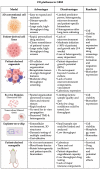Functional Precision Oncology: The Next Frontier to Improve Glioblastoma Outcome?
- PMID: 35955765
- PMCID: PMC9369403
- DOI: 10.3390/ijms23158637
Functional Precision Oncology: The Next Frontier to Improve Glioblastoma Outcome?
Abstract
Glioblastoma remains the most malignant and intrinsically resistant brain tumour in adults. Despite intensive research over the past few decades, through which numerous potentially druggable targets have been identified, virtually all clinical trials of the past 20 years have failed to improve the outcome for the vast majority of GBM patients. The observation that small subgroups of patients displayed a therapeutic response across several unsuccessful clinical trials suggests that the GBM patient population probably consists of multiple subgroups that probably all require a distinct therapeutic approach. Due to extensive inter- and intratumoral heterogeneity, assigning the right therapy to each patient remains a major challenge. Classically, bulk genetic profiling would be used to identify suitable therapies, although the success of this approach remains limited due to tumor heterogeneity and the absence of direct relationships between mutations and therapy responses in GBM. An attractive novel strategy aims at implementing methods for functional precision oncology, which refers to the evaluation of treatment efficacies and vulnerabilities of (ex vivo) living tumor cells in a highly personalized way. Such approaches are currently being implemented for other cancer types by providing rapid, translatable information to guide patient-tailored therapeutic selections. In this review, we discuss the current state of the art of transforming technologies, tools and challenges for functional precision oncology and how these could improve therapy selection for GBM patients.
Keywords: drug sensitivity; functional precision oncology; glioblastoma.
Conflict of interest statement
The authors declare no conflict of interest.
Figures


Similar articles
-
Current status of precision oncology in adult glioblastoma.Mol Oncol. 2024 Dec;18(12):2927-2950. doi: 10.1002/1878-0261.13678. Epub 2024 Jun 20. Mol Oncol. 2024. PMID: 38899374 Free PMC article. Review.
-
Functional precision oncology: Testing tumors with drugs to identify vulnerabilities and novel combinations.Cancer Cell. 2022 Jan 10;40(1):26-35. doi: 10.1016/j.ccell.2021.12.004. Epub 2021 Dec 23. Cancer Cell. 2022. PMID: 34951956 Free PMC article. Review.
-
Omics sciences and precision medicine in glioblastoma.Clin Ter. 2023 Nov-Dec;174(Suppl 2(6)):77-84. doi: 10.7417/CT.2023.2474. Clin Ter. 2023. PMID: 37994751 Review.
-
Rapid identification and validation of novel targeted approaches for Glioblastoma: A combined ex vivo-in vivo pharmaco-omic model.Exp Neurol. 2018 Jan;299(Pt B):281-288. doi: 10.1016/j.expneurol.2017.09.006. Epub 2017 Sep 18. Exp Neurol. 2018. PMID: 28923369 Review.
-
Patient-derived tumor organoid predicts drugs response in glioblastoma: A step forward in personalized cancer therapy?J Clin Neurosci. 2020 Aug;78:400-402. doi: 10.1016/j.jocn.2020.04.107. Epub 2020 Apr 24. J Clin Neurosci. 2020. PMID: 32340843 Review.
Cited by
-
Determining the Research Priorities for Adult Primary Brain Tumours in Australia and New Zealand: A Delphi Study with Consumers, Health Professionals, and Researchers.Curr Oncol. 2022 Dec 17;29(12):9928-9955. doi: 10.3390/curroncol29120781. Curr Oncol. 2022. PMID: 36547195 Free PMC article.
-
Different Approaches to Study Molecular Blueprint and Biological Behavior of Brain Tumors: Editorial to the Special Issue "Advances in Molecular Genetics of Brain Tumors".Int J Mol Sci. 2023 Jan 4;24(2):948. doi: 10.3390/ijms24020948. Int J Mol Sci. 2023. PMID: 36674461 Free PMC article.
-
Single-cell molecular profiling using ex vivo functional readouts fuels precision oncology in glioblastoma.Cell Mol Life Sci. 2023 May 12;80(6):147. doi: 10.1007/s00018-023-04772-1. Cell Mol Life Sci. 2023. PMID: 37171617 Free PMC article.
-
Functional precision medicine assay for recurrent meningioma: a proof of principle. Illustrative case.J Neurosurg Case Lessons. 2024 Jul 29;8(5):CASE24242. doi: 10.3171/CASE24242. Print 2024 Jul 29. J Neurosurg Case Lessons. 2024. PMID: 39074389 Free PMC article.
-
Current drug development and trial designs in neuro-oncology: report from the first American Society of Clinical Oncology and Society for Neuro-Oncology Clinical Trials Conference.Lancet Oncol. 2023 Apr;24(4):e161-e171. doi: 10.1016/S1470-2045(23)00005-0. Lancet Oncol. 2023. PMID: 36990614 Free PMC article. Review.
References
-
- Masui K., Gini B., Wykosky J., Zanca C., Mischel P.S., Furnari F.B., Cavenee W.K. A Tale of Two Approaches: Complementary Mechanisms of Cytotoxic and Targeted Therapy Resistance May Inform next-Generation Cancer Treatments. Carcinogenesis. 2013;34:725–738. doi: 10.1093/carcin/bgt086. - DOI - PMC - PubMed
-
- Sampaio M.M., Santos M.L.C., Marques H.S., Gonçalves V.L.d.S., Araújo G.R.L., Lopes L.W., Apolonio J.S., Silva C.S., Santos L.K.d.S., Cuzzuol B.R., et al. Chronic Myeloid Leukemia-from the Philadelphia Chromosome to Specific Target Drugs: A Literature Review. World J. Clin. Oncol. 2021;12:69–94. doi: 10.5306/wjco.v12.i2.69. - DOI - PMC - PubMed
Publication types
MeSH terms
LinkOut - more resources
Full Text Sources
Medical
Miscellaneous

